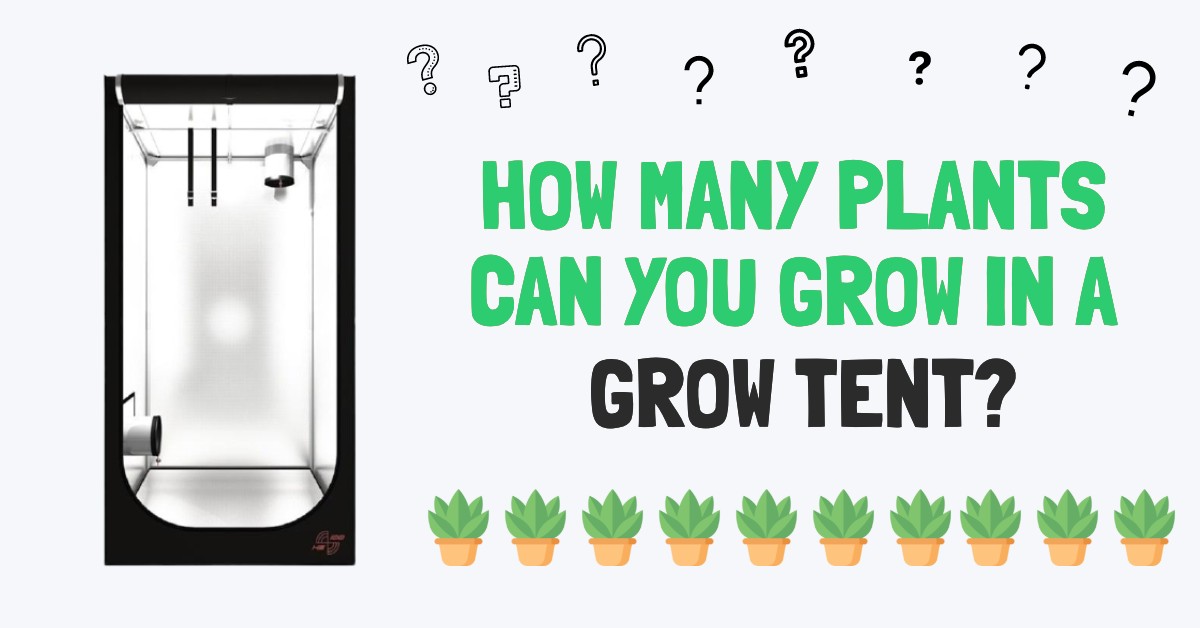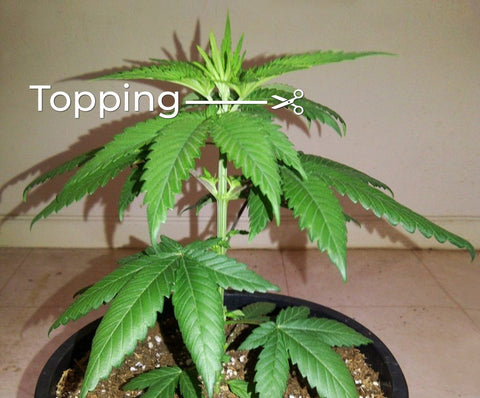
Are you planning to start an indoor grow room? Indoor grow setups usually involve the use of grow tents, which helps growers control the environment of the plants. You get to set when sunrise and sunset takes place when used in tandem with
LED grow lights And you control the environment inside by monitoring and shifting temperatures and
humidity levels.
One of the things taken for granted in planning an indoor grow setup is the number of plants you can put inside. Some growers make that mistake of underutilizing grow tent real estate when they could have put more plants, as more plants means a larger harvest. That said, it is imperative to know how many plants you can put inside a grow tent, given the dimensions, so that you can efficiently use your gardening assets with minimal wastage.
So, how many plants can one grow in the most common grow tent sizes? And the answer is:
it depends.
Table of Contents
Your Grow Tent
It may seem pretty obvious but the size of your grow tent sets the absolute limit for how much plants it can house. While usable floor space is the primary constraint, vertical space is an important consideration too, along with the shape of your tent. Thus, Choosing the right grow tent dimensions (length, width, and height) is the first step towards maximizing the potential of your indoor garden to grow various strains.
Here's a quick reference on common sizes and how many plants they can comfortably accommodate:
Common Grow Tent Sizes
| Grow Tent Size | Estimated Plant Capacity |
|---|---|
| 2' x 2' | 1-4 plants |
| 3' x 3' | 2-6 plants |
| 4' x 4' | 4-16 plants |
| 5' x 5' | 6-20 plants |
| 8' x 8' | 16-30+ plants |
Important Note: These are just estimates. The actual number of plants you can fit depends on factors like plant variety, pot size, and your chosen growing techniques.
How Grow Tent Dimensions Impact Space
Think of your indoor garden less like a traditional garden and more like a multilevel apartment building for plants:
- Floor Space is King: The primary limitation is the floor area of your tent. This defines the absolute maximum number of plant containers you can fit.
- Height Matters: Taller tents give you the freedom to grow larger plants or to use techniques like vertical stacking to increase your overall plant capacity.
- Shape Also Plays a Role: Square tents usually allow for slightly more efficient space utilization compared to rectangular tents with the same floor area.
Now that gave you a table showing different sizes and plant counts... guess we're done with the article, right?
But wait, there's more—Turns out, the way you grow your plants also plays a huge role in how many you can comfortably fit in your tent.
Think of it like this: you can pack a suitcase with a lot of socks and t-shirts, but fewer bulky sweaters. The same goes for your grow tent - growing methods like the Sea of Green (SOG) let you pack in many small plants, while techniques like Screen of Green (ScrOG) focus on fewer plants trained to create a sprawling canopy.
Let's delve into how these different techniques can transform your grow tent's potential...
Indoor Growing Methods
The way you choose to grow your plants will significantly impact how you utilize your grow tent's space. Before diving into tent sizes, let's explore some popular indoor growing methods and how they affect your plant count.
There are four (4) growing styles you can use with a grow tent, each having its set of advantages and disadvantages. These growing styles also affect how many plants you can put inside a grow tent, so it would be good to see which one you should go for, vis-à-vis your grow tent size.
Screen of Green

The Screen of Green growing style employs a screen that helps you track the height of your cannabis plant so that you can prune them accordingly. The Screen of Green offers benefits, such as less water and nutrients consumption, efficient use of growing space, and works with seedlings and cuttings. It also only needs 0.25 square feet of space, so you can make the most of the grow tent. But, a Screen of Green needs growers to be extra meticulous. If you plan to use a Screen of Green style, you should track the growth of your plant so you can prune them, as needed. Screen of Greens often works better with Sativas, so that should be something to consider.
-
Advantages: ScrOG can significantly boost yield per plant and is excellent for utilizing every inch of available light. It's a great option for grow tents with limited height.
-
Disadvantages: ScrOG involves more hands-on plant manipulation and generally requires a slightly longer vegetative stage for the plants to properly fill out the screen.
Topping

Topping involves pruning the highest part of the plant and takes advantage of stress-exposure to induce the production of more buds. You’d use this technique to increase yields without adding any more enhancers. This style has the potential of having more colas after trimming the main cola. This method lets you make the most out of the capacity of your plants. Aside from more colas, topping your plant makes room for better light absorption. While topping can be done anytime, it is best done during mature stages, which makes colas more accessible and visible. If you plan to do topping on your cannabis, you need to earmark at least 0.75 square feet of space.
-
Advantages: Topping results in bushier plants with multiple main bud sites, potentially boosting overall yield. It also helps create an even canopy for optimal light absorption.
-
Disadvantages: Topping can slightly increase the vegetative growth period. It may not be ideal for those seeking super-fast harvests or with very limited grow space.
Low-Stress Training

Low-Stress Training is a growing style that maximizes grow space and light while keeping height uniform. As cannabis grows into a more conical-shape, Low-Stress Training changes the growth direction towards a horizontal spread to keep the height of your plants uniform. Since the Low-Stress Training directs the stalk of the plant to move horizontally, the ideal grow space per plant is pegged at two (2) square feet.
- Advantages: LST leads to efficient light distribution and improved bud quality. It's easy to implement and gentle on your plants.
- Disadvantages: LST can be more time-consuming as it involves regular plant manipulation. It may not be ideal for growing a large number of plants due to space constraints.
Sea of Green

A Sea of Green is a low-stress growing technique that works best for smaller cannabis plants. If done right, you can get a high number of yields in a lesser amount of time and can do many harvests in a year.
Compared to the Screen of Green method, the Sea of Green focuses on having more plants and get them to harvest at a faster time, while the Screen of Green prolongs vegetation periods.
One advantage of the Screen of Green method is that it can provide more yields in a lesser period, have many layers stacked, it does not need much vertical space, and works exceptionally for commercial-scale growing. But, a Sea of Green needs more attention, is more prone to pests and plant diseases, and if you are not careful enough, you may break local laws on cultivating cannabis. If you plan to do a Sea of Green, you need at least one (1) square foot of space per plant.
-
Advantages: SOG maximizes space utilization, offers frequent harvests, and is well-suited to smaller grow operations.
-
Disadvantages: SOG often requires more plants and may not be the best choice for those targeting the absolute largest buds on each plant.
Calculating Your Grow Tent's Capacity
As a rule of thumb, consider these allocations for each plant per square foot:
- Sea of Green: 1 square foot per plant
- Screen of Green: 0.25 square foot per plant
- Topping: 0.75 square foot per plant
- Low-Stress Training: 2 square foot per plant
Remember, these are merely guidelines for how many plants to grow. Cannabis cultivation requires flexibility, as several factors influence the final size and shape of your plants such as:
- Space for Your Equipment: Remember that your grow lights, ventilation system, and perhaps a small humidifier/dehumidifier will occupy some space. Also, leave room for walkways if your tent is large enough to enter. Subtract this from your total floor space for a more accurate plant count.
- Pot size smaller pots allow for tighter spacing, while larger pots provide space for root growth and bigger plants. The length of the vegetative stage also matters; a longer veg time means larger plants needing more space.
- Training techniques like topping or LST also significantly alter plant shape. Aggressively trained plants become wider and bushier, demanding more room in your grow tent.
Keep in mind that each growing style has advantages and disadvantages, so it's wise to consider these factors when choosing your grow tent.
How Many Plants Can You Fit in Popular Grow Tent Sizes?
Now that you are familiar with the possible growing methods, here’s a quick breakdown of how many you can put in your tent.
Note that in some cases, you may encounter extra space that can still fit in another plant or two. Should you fill that space? It is highly discouraged to fill in those gaps you may find. You would want to have an equal distribution of lights and nutrients so the plants grow properly.
Grow tents also have added equipment to aid in the growth of your plants, so you have to factor in these tools in your space.
2' x 2' Grow Tents

- Sea of Green: 4-9 plants
- Screen of Green: 1-2 plants
- Low-Stress Training: 2-4 plants
- Topping: 1-2 plants
2' x 4' Grow Tents

- Sea of Green: 4-8 plants
- Screen of Green: 1-2 plants
- Low-Stress Training: 2-4 plants
- Topping: 2-4 plants
3' x 3' Grow Tents

- Sea of Green: 9-12 plants
- Screen of Green: 1-2 plants
- Low-Stress Training: 4-6 plants
- Topping: 4-5 plants
4' x 4' Grow Tents

- Sea of Green: 16-25 plants
- Screen of Green: 1-2 plants
- Low-Stress Training: 4-6 plants
- Topping: 4-6 plants
5' x 5' Grow Tents

- Sea of Green: 25-36 plants
- Screen of Green: 2-4 plants
- Low-Stress Training: 12 plants
- Topping: 6-9 plants
Easy Grow Tent Plant Calculator
Calculating your grow tent's capacity shouldn't be complicated. Try our simple calculator below for quick, accurate results and a stress-free start to your growing journey.
Conclusion
The number of plants you can have on a grow tent will always depend on the goals for the harvest. You need to think about it closely, as it is not recommended to shift in the middle of the growth cycle. You may compromise the quality of the plant, should you decide to do so. With that in mind, you may want to try out different growing styles so you can determine which works best for you.
Additional Resources:




